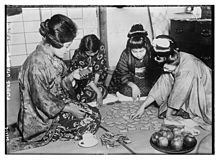Uta-garuta

Uta garuta being played by women in traditional dress
Uta-garuta (歌ガルタ) are a kind of karuta, Japanese traditional playing cards. It is also the name of the game in which they are used. The game is played mostly on Japanese New Year's holidays. On each card, a poem (waka) is written, and there are a total of 100 poems. The standard collection of the poems used is called Hyakunin Isshu, which is often also the name of the game. The collection was chosen by a poet Fujiwara no Teika in Heian period. There are national conventions for the game. Levels start at the lowest, Class E, and stop at the highest, Class A. Only Class A players are qualified to be a reader.
How to play
Basic rule
The game uses two types of cards.
- Yomifuda: One hundred reading cards with a figure of a person, their name and poem on each one
- Torifuda: One hundred grabbing cards with only the lower phrases of poems
At the start of a game, 50 torifuda are neatly arranged on the floor faced up. When the reader starts reading out a poem on the yomifuda, the players quickly search for the torifuda on which the corresponding lower phrase is written.
There are two ways to play the game based on the rule above.
Chirashi-dori
One reader, more than three players:
- Mix up the deck of torifuda, and lay them out on the floor. Players sit around the cards.
- The reader starts reading out the waka, and players take corresponding torifuda as fast as possible. They can do it immediately when they already know the lower phrase.
- When a torifuda was taken, the reader moves on to the next waka.
- When all the cards are taken, the player with the most cards wins the game.
Genpei-gassen
One reader, players on two sides:
- Divide the players into two groups. One is called the Genji side and the other the Heike side.
- Mix up the torifuda, and give 50 cards to each side.
- Genji and Heike sit face to face. Lay out 50 cards in front of each group in three lines to face the group.
- The way to take the torifuda is the same as with Chirashi-dori.
- Players can take cards on both sides.
- When they took cards on the opponent side, they can move one card to the side of the opponent.
- If they take a wrong card, the opponent can move a card from their side.
- The side that takes all the torifuda on their side wins the game.
The odds of winning increase if one knows the phrases. One even may be able to take the cards immediately after hearing the reader read aloud only the first letters of the waka. Readers are also very important, having to know how to correctly space out the words and the seconds of the pause.
COMMENTS








 Uta garuta being played by women in traditional dress
Uta garuta being played by women in traditional dress